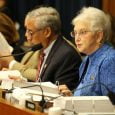
Federal student loan interest rates just went up again for the second year in a row.
Interest rates for student loans borrowed under the Department of Education’s direct program rose by 0.6 percent for the 2018-2019 school year. Undergraduate direct loans now carry the highest interest rate since the 2009-2010 year during the Great Recession. Effective July 1, undergraduates who take out a federal direct loan will now borrow at a 5.05 interest rate – a 13 percent increase compared to the 3.76 percent rate from the prior school year.
Graduate students will also pay more. The new interest rate for a graduate unsubsidized direct loan is 6.6 percent – up from 6 percent from the 2017-2018 school year – and the rate for a PLUS loan for either graduate students or parents is now a staggering 7.6 percent – the highest rate in more than five years.
Over the last two years, federal student loan rates have risen by 1.29 percentage points.
The current system for setting rates on direct loans has only been in place since July 2013 and was introduced under the Obama administration. Under this system, the Department of Education changes fixed-interest rates on direct loans each year based on the 10-year Treasury note auction in May.
Student loan experts say consumers should expect interest rate hikes on federal student loans to become the new normal. College students may see higher rates each year they take out a federal loan, they say.
“The trends and predictions indicate that interest rates are going to continue to trend up,” says Amy Glynn, vice president of financial aid and community initiatives at CampusLogic, a software company that provides student financial services. “The current rates for the 18-19 aid year are inching closer the statutory maximum interest rates.”
Increases in interest rates make higher education even more expensive. A higher interest rate can raise monthly loan payments and total repayment costs when borrowers are paying back thousands of dollars. A college grad paying back $30,000 in student loans can rack up around $8,721 in interest under the standard 10-year repayment plan at the new rate of 5.05 percent. Compare that with the direct undergraduate interest rate from two years ago under the same plan, which was $6,039.
[Read: How to Learn About College Affordability in High School.]
Amid rising interest rates, here are a few strategies for current and prospective students to reduce the amount they pay in interest on student loans.
Students should limit borrowing. Students and parents should try to reduce reliance on student loans, experts say.
One way to reduce student loan dependence is to limit borrowing to direct costs, the amount actually billed by a college, and cover living expenses by alternative means like working, says Glynn, who used to work as a financial aid director at the Santa Fe University of Art and Design.
“Alternatives like 529 plans, scholarships, payment plans and employer reimbursement should seriously be considered by families to reduce reliance on student loans,” she says.
Private education loans may be cheaper than parent PLUS loans. Parents who are paying for college with loans should look at the private lending market before signing on with a federal parent PLUS loan, says Stephen Dash, founder and CEO of Credible.com, a multilender marketplace focused on student loans. He adds that parent PLUS loans are different than other federal student loans because these loans don’t carry the same protections, such as eligibility for several different types of income-based repayment plans.There’s also an upfront disbursement fee associated with the PLUS loan – it puts the APR at over 8 percent. So if you qualify for a private loan and you’re looking at PLUS loans versus private loans, private loans can make a lot of sense because you are comparing an apples-to-apples comparison,” he says.
MBA students may find better rates in the private market. “Graduate schools students, such as MBAs, who are unlikely to be in a loan forgiveness program should be particularly hard hit,” says Alexander Lowry, a professor of finance at Gordon College in Massachusetts.
Lowry says MBA students are paying hefty tuition, sometimes more than $100,000 for their education, and are unlikely post-graduation to go into the nonprofit and public sector, where the federal Public Service Loan Forgiveness could be an option. PSLF discharges student debt for eligible borrowers after they’ve made 120 on-time payments.
But experts says there are alternatives, such as specialized MBA loans that offer lower interest rates compared with federal graduate loans, which include PLUS and direct graduate Stafford. Direct graduate Stafford loans typically carry a lower interest rate than graduate PLUS loans, but there’s an allowable maximum borrowing limit of $20,500 per academic year.
The current fixed rate for a 10-year fixed-rate loan for MBA students at New York-based CommonBond starts at 6.58 percent – more than a 1 percentage point difference compared with graduate PLUS loans. Discover Student Loans, headquartered in Illinois, offers variable rates as low as 3.99 percent for MBA students.
“When it comes to the graduate Stafford loan, you want to be confident that you would never need those protections. And it depends on the saving as well,” Dash says.
For some graduate students, he says, it can be worth paying extra in interest for federal student loans because of their protections, such as possible loan forgiveness and flexible repayment plans. “The additional cost is like an insurance premium,” he says.
Trying to fund your education? Get tips and more in the U.S. News Paying for Collegecenter.
Source:-usnews.




